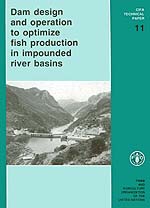
CIFA TECHNICAL PAPER 11 CIFA/T11
 | Dam design and operation to optimize fish production
in impounded river basins |
Based on a Review of the Ecological Effects of Large Dams in Africa
by
G.M. Bernacsek
Fishery Biologist
Rome
The designations employed and the presentation of material in this publication do not imply the expression of any opinion whatsoever on the part of the Food and Agriculture Organization of the United Nations concerning the legal status of any country, territory, city or area or of its authorities, or concerning the delimitation of its frontiers or boundaries.
M-43
ISBN 92-5-101485-X
All rights reserved. No part of this publication may be reproduced, stored in a retrieval system, or transmitted in any form or by any means, electronic, mechanical, photocopying or otherwise, without the prior permission of the copyright owner. Applications for such permission, with a statement of the purpose and extent of the reproduction, should be addressed to the Director, Publications Division, Food and Agriculture Organization of the United Nations, Via delle Terme di Caracalla, 00100 Rome, Italy.
PREPARATION OF THIS DOCUMENT
This publication is one of a series of documents dealing with FAO/Committee for Inland Fisheries of Africa (CIFA) activity on increasing benefits from African reservoir fisheries. It was initiated by a recommendation from the Roundtable on African Reservoir Fisheries, held in Cairo, Egypt, from 11 to 13 January 1983 to the CIFA Fifth Session, also held in Cairo, 15–20 January 1983.
Cover photograph: Cahora Bassa, Mozambique (by author).
| Distribution: | For bibliographic purposes this document should be cited as follows: |
| CIFA Mailing list FAO Fisheries Department FAO Regional Fishery Officers Selector SI | Bernacsek, G.M., 1984 Guidelines for dam design and operation to optimize fish production in impounded river basins (based on a review of the ecological effects of large dams in Africa). CIFA Tech. Pap., (11):98 p. |
A series of guidelines is presented which is intended to aid dam design and operating engineers to manipulate the artificial aquatic environments upstream and downstream so as to optimize fish production. The guidelines are based on reviews and in some cases new analyses of the known effects of dam design and operation on African reservoirs, downstream river channels and coastal marine habitats. The study indicates that the following dam design or operational features are desirable: maximum possible crest elevation; discharge structure intakes positioned at highest possible elevation; artificial reoxygenation of tailrace discharge water; annual water level fluctuation of the reservoir to be within the range of 2.5–4.0 m and drawdown rate not to exceed 0.6 m/month; and downstream discharge to include an annual artificial flood event. Installation of fish ladders is generally not recommended. An incomplete register of 320 large dams/reservoirs in Africa was assembled, but the actual number is thought to be between 600 and 800. The combined surface area is about 41 000 km2 at full capacity. The historical trend of dam construction in Africa was examined. |
Key words: large dams, reservoirs, dam engineering, drawdown, environmental impact, impounded rivers, lagoons, estuaries, coastal erosion, aquatic macrophytes, bivalves, fish biology, fisheries, Africa. |

FOOD AND AGRICULTURE ORGANIZATION OF THE UNITED NATIONS
Rome, © FAO 1984
Hyperlinks to non-FAO Internet sites do not imply any official endorsement of or responsibility for the opinions, ideas, data or products presented at these locations, or guarantee the validity of the information provided. The sole purpose of links to non-FAO sites is to indicate further information available on related topics.
This electronic document has been scanned using optical character recognition (OCR) software. FAO declines all responsibility for any discrepancies that may exist between the present document and its original printed version.
1. SUMMARY OF FISHERY GUIDELINES FOR DAM DESIGN AND OPERATION
1.1 Basic Principles
1.2 Dam Design
1.3 Dam Operation
3. REGISTER OF AFRICAN DAMS AND RESERVOIRS
4. MAIN TYPES OF DAMS AND RESERVOIRS
5. REVIEW OF DAM DESIGN AND OPERATION EFFECTS ON RESERVOIR FISH PRODUCTION
5.1 Reservoir Size
5.2 Water Level Fluctuation
5.2.1 Design rule curve
5.2.2 Comparison among African reservoirs
5.2.3 Physical and chemical environment
5.2.4 Vegetation
5.2.5 Benthic invertebrates
5.2.6 Fish production and fisheries
6. REVIEW OF DOWNSTREAM EFFECTS OF DAM DESIGN AND OPERATION
6.1 River Channel and Floodplain
6.1.1 Discharge water quantity and quality
6.1.2 Aquatic macrophytes
6.1.3 Fisheries
6.2.1 Hydrology
6.2.2 Coastal erosion
6.2.3 Fisheries